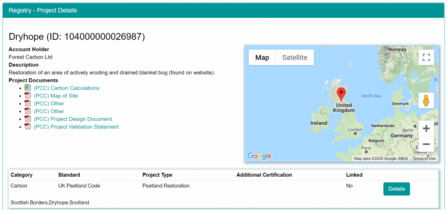To maintain the transparency and robust accounting required as part of the management of the Peatland Code, all projects have now moved onto a new online registry. The new registry places both Peatland Code and Woodland Carbon Code projects within the IHS Markit Environmental Registry platform and creates a more accessible ‘one-stop-shop’ for woodland and peatland carbon schemes under the umbrella of the UK Land Carbon Registry.
Interest in carbon credits for both woodland and peatland schemes has grown rapidly over the past year with many companies looking to compensate for their residual emissions through nature based solutions. The number of Peatland Code projects within the registry has recently doubled in size to 24 projects and we are seeing unprecedented interest from brokers, new project developers, investors and landowners.
In addition to the rigorous checks which are already undertaken as part of the Peatland Code and independent assessment by a certification body, the registry gives additional reassurance to investors:
• Projects have full traceability and transparency as they move through the Code process. Documents relating to the project location, restoration plans and carbon emissions calculations are all available to view.
• The status of a project is clearly visible and projects can be traced as they move along the Code’s project timeline from ‘under development’ to ‘validated’ to ‘verified’.
• Units are generated once projects are certified and these units are all logged within the registry system. Units are fully traceable as they are bought and sold to ensure that there is no double counting.
The development of the UK Land Carbon Registry was jointly funded by Defra and NatureScot Peatland ACTION.
Welcoming the formation of the new registry, Scotland’s Rural Economy Secretary Fergus Ewing said,
“We recognise the role that woodlands and carbon sequestration have to play and wish to see an increase in the size of the woodland carbon market by 50 per cent over the next five years. Added to this, the Scottish Government is committed to seeing the rate of peatland restoration programmes grow over the coming years.
“The new UK Land Carbon Registry will create a more joined up marketplace for those wishing to invest and offset their emissions – this is good news for woodland creation and peatland restoration.”
A Defra spokesperson, highlighting the business and reporting need for the new registry, said;
“Around 12,000 large businesses across the UK now have a statutory duty to report their greenhouse gases alongside their annual accounts. This has spurred on many companies to seek ways to offset their carbon emissions.
The increase in demand will, in turn, drive more private sector investment into creating more woodlands and peatland restoration programmes across the UK.
Currently, around 526 woodland creation projects have registered with the UK’s Woodland Carbon Code, with 40 per cent being in Scotland. This represents a doubling of projects compared to the past year alone and these registered projects are predicted to sequester over 8 Million tonnes CO2 over their lifetime.
Interest is also booming for the Peatland Code which has also seen a doubling of the number of registered projects in the last year – bringing the total to 24 projects. There are currently 4 validated projects which will reduce emissions from degraded peatlands by around 100,000 tonnes CO2e over their lifetime”.
Brendan Turvey, NatureScot’s Low Carbon Project Manager, said,
“We’re very pleased to see the new register launched and hope this will start to draw more private investment in to peatland restoration in Scotland. We will help make this happen through the continued support of Scottish Government funding for Peatland Action, and look forward to working with partners, land owners and investors to leverage private investment.”

